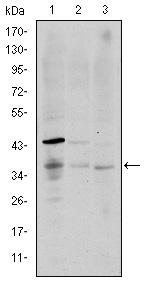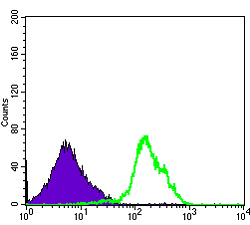CD1A Monoclonal Antibody
- Catalog No.:YM0110
- Applications:WB;FCM;ELISA
- Reactivity:Human
- Target:
- CD1A
- Fields:
- >>Tight junction;>>Hematopoietic cell lineage;>>Amoebiasis
- Gene Name:
- CD1A
- Protein Name:
- T-cell surface glycoprotein CD1a
- Human Gene Id:
- 909
- Human Swiss Prot No:
- P06126
- Immunogen:
- Purified recombinant fragment of human CD1A expressed in E. Coli.
- Specificity:
- CD1A Monoclonal Antibody detects endogenous levels of CD1A protein.
- Formulation:
- Liquid in PBS containing 50% glycerol, 0.5% BSA and 0.02% sodium azide.
- Source:
- Monoclonal, Mouse
- Dilution:
- WB 1:500 - 1:2000. Flow cytometry: 1:200 - 1:400. ELISA: 1:10000. Not yet tested in other applications.
- Purification:
- Affinity purification
- Storage Stability:
- -15°C to -25°C/1 year(Do not lower than -25°C)
- Other Name:
- CD1A;T-cell surface glycoprotein CD1a;T-cell surface antigen T6/Leu-6;hTa1 thymocyte antigen;CD antigen CD1a
- Molecular Weight(Da):
- 37kD
- References:
- 1. J Neuroimmunol. 2008 Dec 15;205(1-2):110-2.
2. Pathol Int. 2008 Mar;58(3):169-73.
- Background:
- This gene encodes a member of the CD1 family of transmembrane glycoproteins, which are structurally related to the major histocompatibility complex (MHC) proteins and form heterodimers with beta-2-microglobulin. The CD1 proteins mediate the presentation of primarily lipid and glycolipid antigens of self or microbial origin to T cells. The human genome contains five CD1 family genes organized in a cluster on chromosome 1. The CD1 family members are thought to differ in their cellular localization and specificity for particular lipid ligands. The protein encoded by this gene localizes to the plasma membrane and to recycling vesicles of the early endocytic system. Alternative splicing results in multiple transcript variants. [provided by RefSeq, Mar 2016],
- Function:
- function:Antigen-presenting protein that binds self and non-self lipid and glycolipid antigens and presents them to T-cell receptors on natural killer T-cells.,miscellaneous:During protein synthesis and maturation, CD1 family members bind endogenous lipids that are replaced by lipid or glycolipid antigens when the proteins are internalized and pass through endosomes, before trafficking back to the cell surface.,similarity:Contains 1 Ig-like (immunoglobulin-like) domain.,subcellular location:Subject to intracellular trafficking between the cell membrane and endosomes. Localizes to cell surface lipid rafts.,subunit:Heterodimer with B2M (beta-2-microglobulin). Interacts with CD74.,tissue specificity:Expressed on cortical thymocytes, epidermal Langerhans cells, dendritic cells, on certain T-cell leukemias, and in various other tissues.,
- Subcellular Location:
- Cell membrane ; Single-pass type I membrane protein . Membrane raft ; Single-pass type I membrane protein . Endosome membrane ; Single-pass type I membrane protein . Subject to intracellular trafficking between the cell membrane and endosomes (PubMed:11231314). Localizes to cell surface lipid rafts (PubMed:18178838). .
- Expression:
- Expressed on cortical thymocytes, epidermal Langerhans cells, dendritic cells, on certain T-cell leukemias, and in various other tissues.
- June 19-2018
- WESTERN IMMUNOBLOTTING PROTOCOL
- June 19-2018
- IMMUNOHISTOCHEMISTRY-PARAFFIN PROTOCOL
- June 19-2018
- IMMUNOFLUORESCENCE PROTOCOL
- September 08-2020
- FLOW-CYTOMEYRT-PROTOCOL
- May 20-2022
- Cell-Based ELISA│解您多样本WB检测之困扰
- July 13-2018
- CELL-BASED-ELISA-PROTOCOL-FOR-ACETYL-PROTEIN
- July 13-2018
- CELL-BASED-ELISA-PROTOCOL-FOR-PHOSPHO-PROTEIN
- July 13-2018
- Antibody-FAQs
- Products Images

- Western Blot analysis using CD1A Monoclonal Antibody against K562 (1), RAJI (2), and MOLT4 (3) cell lysate.

- Flow cytometric analysis of RAJI cells using CD1A Monoclonal Antibody (green) and negative control (purple).




